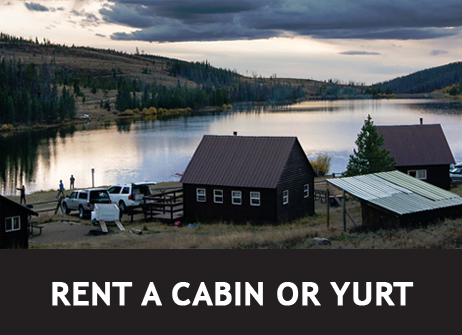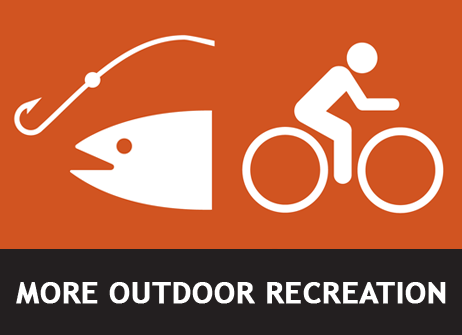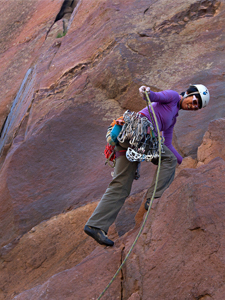More Outdoor Recreation Information



Rock Climbing Overview
Most climbers practice “free climbing”. Many people assume that “free climbing” means rock climbing without a rope and other safety equipment. However, such climbing is known as “un-roped soloing” and, even on relatively easy terrain, should be reserved for experts willing to risk their lives.
In reality, “free climbing” contrasts with “aid climbing”. When “free climbing,” climbers use only their hands and feet to ascend the rock. Un-roped soloists are practicing one particular form of “free climbing.” Most free climbers, however, do use ropes and other safety equipment, but only to catch them in the event of falls, not to help them ascend the rock. When “aid climbing”, climbers actually pull on or stand up on their equipment to ascend the rock. Aid climbing is most often employed on big walls such as Yosemite National Park’s El Capitan. When climbers come to Colorado State Parks, they are typically looking to free climb.
Equipment
 Most climbers use equipment called “protection” while climbing. Aid climbers use protection to make upwards progress and to catch them in the event of falls. Most free climbers also use protection, but only to catch them in the event of falls.
Most climbers use equipment called “protection” while climbing. Aid climbers use protection to make upwards progress and to catch them in the event of falls. Most free climbers also use protection, but only to catch them in the event of falls.
Two types of protection are removable and fixed protection. Removable protection consists of chocks (metal wedges slotted into downward tapering cracks) and cams (devices that hold in parallel of even slightly downward flaring cracks). Fixed protection consists of pitons (metal spikes hammered into cracks in the rock, rarely placed nowadays) and bolts (semi-permanent anchors placed in holes drilled in the rock). Climbers also use slings or “quick draws” (short slings with carabineers at each end) to clip their climbing rope into their protection. In addition, climbers use belay devices to lock up the climbing rope in the event of a fall. Other typical equipment includes ropes, climbing shoes, harnesses, helmets, carabineers (metal snap links) and gymnastic chalk (to improve grip).
Types of climbing
BOULDERING involves climbing on boulders or small cliffs generally only up to a height where a fall would not be extremely serious. Bouldering may be a relatively inexpensive way to first try rock climbing; the only typical requirements are climbing shoes, a chalk bag (to improve grip) and the sense not to climb high enough for any potential falls to be dangerous. When bouldering, many people also use specially designed “crash pads” to cushion any falls as well as a “spotter” or partner to help protect them in the event of a fall.
TOP ROPING also provides a good introduction to the sport. To top rope, climbers scramble up the backside of a cliff that is typically less than 100 feet high. They set their own anchor with removable protection (chocks and cams) or use carabiners and slings to clip into fixed anchors (often bolts). The climbers then clip their rope to the anchor with locking carabiners and drop both ends of the rope to the ground. Once back at the base of the climb, one climber ties into one end of the rope and another climber runs the other side of the rope through a belay device clipped to their harness. As the climber ascends, the belayer takes in rope, all the while using proper belay technique to be ready to lock the rope in the belay device in the event of a fall. Since the rope runs down to the climber, he or she should only fall a short distance due to rope stretch, thus making top roping a relatively safe means to first get into rock climbing. Nevertheless, basic anchor setting, knot tying, and rope management skills are mandatory, along with a somewhat more extensive array of equipment including a rope, climbing protection, slings, carabiners, a belay device, harnesses, and helmets.
FOLLOWING a rock climb could be considered the next step up in the evolution of a climber. Following is simply the second person to climb in lead climbing situations, which are described below.
LEAD CLIMBING is when two (occasionally more) climbers start from the base of a cliff and work their way directly up the rock face. As the first person (the leader) climbs, they periodically stop, place and clip their rope into their own removable protection (chocks and cams) and/or clip their rope into fixed protection (bolts and pitons). The second person feeds rope up to the leader through a belay device clipped to their harness. If the leader falls, he or she would fall double the distance to their last piece of protection. The belayer would lock up the rope with the belay device and the leader would fall another several feet of rope stretch. The length the leader falls can be significant, although the danger isn’t so much in the distance as it is in how much there is to hit on the way down. A long leader fall on steep, overhanging rock may result in simply falling into space whereas a relatively short fall into a ledge can result in serious injuries.
 Within a rope length (generally 200 feet) and often far less, the leader stops, anchors to the rock and belays the second climber up the route. Since the rope runs down to the second (except if horizontal traverses are involved) they should only fall a few feet of rope stretch, making seconding (or following) rock climbs a good way for people to gain climbing experience. The second climber (or follower) “cleans” the route by retrieving any removable protection and unclipping from any fixed protection as they ascend the rock. When the second climber reaches the lead climber, they should have all their equipment back and the process is repeated until they reach the top. To get down, climbers either hike down the back side or rappel directly down the rock using a rappel device to slide down their rope looped at its midpoint through an anchor. To retrieve their rope they simply pull on one end until the other end works its way up through the anchor and falls down to them. The anchor stays in place since the climbers have no way to retrieve it once they have descended.
Within a rope length (generally 200 feet) and often far less, the leader stops, anchors to the rock and belays the second climber up the route. Since the rope runs down to the second (except if horizontal traverses are involved) they should only fall a few feet of rope stretch, making seconding (or following) rock climbs a good way for people to gain climbing experience. The second climber (or follower) “cleans” the route by retrieving any removable protection and unclipping from any fixed protection as they ascend the rock. When the second climber reaches the lead climber, they should have all their equipment back and the process is repeated until they reach the top. To get down, climbers either hike down the back side or rappel directly down the rock using a rappel device to slide down their rope looped at its midpoint through an anchor. To retrieve their rope they simply pull on one end until the other end works its way up through the anchor and falls down to them. The anchor stays in place since the climbers have no way to retrieve it once they have descended.
There are two general categories of lead climbing:
SPORT CLIMBING involves the lead climber clipping the rope into preplaced, semi-permanent bolts via “quick draws” (slings with carabiners at each end). In addition to the equipment needed for bouldering and top roping, sport climbers need only a rack of a dozen or so quick draws. In addition to only requiring a modest amount of additional equipment, sport climbing can also be a good way to progress from bouldering, top roping and following routes into lead climbing since it doesn’t require protection (chocks and cams) placement skills. However, there are often few easy to moderate “sport routes,” and the distance between bolts can vary widely, so careful route selection is critical.
TRADITIONAL (TRAD) CLIMBING requires climbers to place their own removable protection (chocks and cams) as they ascend the rock. In addition to the equipment needed for bouldering, top roping, following and sport climbing, traditional climbers need at least a couple dozen chocks and cams and the skill and knowledge to safely place them.
Starting Out
Considering its popularity in Colorado, rock climbing is a fairly complex sport to get started in. Unlike easy-entry sports like paddle boarding, climbing requires training and equipment that aren’t easy to grab on the fly. Don’t let that hold you back, though! The rewarding sport offers stunning views and amazing workouts, and we’ve got some information to get you started.
There’s no real set order for entering the climbing world, and any of these steps can be skipped or switched. You’ve got plenty of options for starting out!
We recommend that you contact a licensed professional to help you get started. The nuanced techniques and their importance to your safety are worth taking a lesson at your
local gym or
picking an instructor’s brain at a state park near you.
Although there are important differences in etiquette and technique between indoor and outdoor climbing, trying out the sport at a gym can be a great way to get started in a controlled environment, surrounded by professionals ready to give you guidance.
If you’re not ready to commit to the full range of equipment required for traditional or sport climbing, bouldering is a nice stepping stone for entry into the sport.
Another potential step into the climbing world is top roping. This is a great option for a beginning climber with an experienced belayer.

